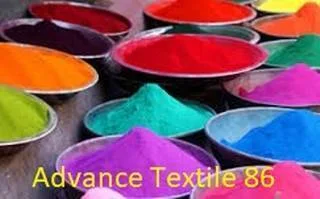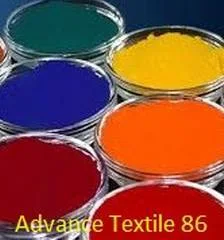Different types of dyes are used in the textile industry
Reactive dyes
Reactive dye is a class of dyes that forms a covalent
bond with the fiber and is an integral part of the fiber. A reactive dye
chromophore has a layer that reacts with the fiber layer. It has good fastness
properties due to the covalent bonding that occurs during dyeing. Reactive dyes
are most commonly used as dyeing cellulose such as cotton or flax, but it is
also dyed with reactive dyes. Reactive dyeing is the most important method for
dyeing cellulosic fibers. Reactive dyes have a lower degree of use than other
types of dyestuffs because the functional group bonds to water, creating
hydrolysis.
Direct dyes
Direct dye is a type of dyestuff that is
applied directly to the substrate for a neutral or alkaline bath. They produce
full shades without shading on cotton and linen and can also be applied to
rayon, silk, and wool. Direct colors give bright shades but the wash fastness
is poor. Used to improve the washing strength of dyes directly after various
treatments. Direct dyes are molecules that adhere to fabric molecules without
the help of other chemicals. Direct dyes are defined as sufficient amounts of
anionic dyes for cellulosic fibers, usually containing sodium chloride (NaCl) or
sodium sulfate (Na2SO4) from an electrolytic water dye
bath.
Acid dyes
Acid dyes are anionic, and water-soluble, and are mainly
applied in acidic baths. These dyes contain acid groups like COOH and SO3H and are applied to wool, silk, and nylon when an ionic bond is formed between the
fibers of the protonated – NH2 group and the acid group of the
pigment. Lightfastness is quite good though overall wash fastness is poor.
Contrary to the electrical nature of such dyes and fibers, the strike rate and
the absorption of acid dyes in these fibers are very fast; Electrolyte
retarding at higher concentrations is added to the formation of dye uptake and
level shades. The acid forms cations on the fibers and the temperature help to
replace the negative part of the acid with the molecules of the anionic dye.
Sulfur dyes
Sulfur dyes are water-insoluble. In the presence of
a reducing agent and at a temperature of about 75°C -80°C of the alkali pH, the
dye particles disintegrate, which later become water-soluble and can therefore be
absorbed by the fabric. Sodium sulfide or sodium hydroxide is a suitable
reducing agent. Simple salts facilitate absorption. After removing the fabric
from the colored solution, it is allowed to stand in the air after which the
dye is dyed by the debris. Dissolved in regenerated parent dye water. Due to
the low water solubility, these colored fabrics are the basis of good wash strength. These dyes are all-around fastness good without chlorine bleach.
Because the dye is water-insoluble, washing it in water will not cause bleeding or
stain other fabrics. It may have poor fastness to rubbing. It may use bleach
like hypochlorite bleach.
Vat dyes
Vat dyes are dyes that are applied by the vating
method on cellulosic fabric. The original vat dye is indigo which is obtained
only from plants but is now often produced synthetically. It has high
colorfastness which is uncommon in other dyes. It has poor rubbing fastness, but
this can be mitigated with special treatments to the fabric. This means that it
is better to dip it multiple times in a weak dye bath than to dip it once in a
strong dye bath. Vat dyes need to be characterized by reducing agents. The most
common reducing agent is sodium dithionite, which converts dye into its leuco
form which is soluble. Once attached to the fabric, the leuco dye is then
oxidized to an invisible state that becomes intensely colored. Chemical
reactions such as oxidation, reduction, and pH control are often necessary; Adequate
amounts of caustic soda and sodium hydrosulfite need to be measured to achieve
even a reduction in the dissolution process. The color is soluble only in its
reduced form. The fiber is repeatedly immersed in this oxygen-free dyebath,
then comes in contact with air, causing the water-soluble reduced form to
change color when the oxygen becomes a water-dissolved form. For this reason,
vat is less suitable for color amateur use than fiber-reactive dyes.
Disperse dyes
Concerns for polyester and related hydrophobic fibers are a category of dispersed synthetic dyes. Disperse dyes are polar molecules that contain the anthraquinone or azo group. It is estimated that 85% of the scattered colors are azo or anthraquinone. These are non-ionic in nature and partially soluble in water. The interaction of dye molecules and polymers occurs with van der Waals and dipole forces. The higher the temperature like 130°C, the better the spread of the dispersed dyes during boiling.
















0 Comments